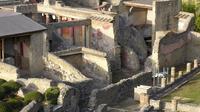Private Tour: Half Day Round Trip to Herculaneum from Naples
Naples, Italy
Trip Type: Private Transfers
Duration: 4 hours
Your chauffeur will reach you directly in front of your hotel in Naples and will drive you to discover Herculaneum where you will visit the most beautiful dwellings of the city: the House of the Mosaic Atrium, the House of Neptune and Amphitrite and the House of the Deer. Your stroll will continue through the Decumanus, the Palestra and the Basilica.
More About This Activity All Private Transfers →
Your chauffeur will reach you directly in front of your hotel in Naples and will drive you to discover Herculaneum where you will visit the most beautiful dwellings of the city: the House of the Mosaic Atrium, the House of Neptune and Amphitrite and the House of the Deer. Your stroll will continue through the Decumanus, the Palestra and the Basilica.Herculaneum was overwhelmed by the same volcanic eruption of Vesuvius as its neighbouring city of Pompeii in AD 79.
Smaller than Pompeii, Herculaneum is less of a household name today but the particular circumstances of the town’s burial mean that many features of Herculaneum bring the past to life more vividly even than Pompeii.
Herculaneum was encased in compacted layers of volcanic material that consolidated into rock, at some points to a depth of up to 25 metres. For this reason many organic features, including wooden beams and furniture, are well preserved at Herculaneum, unlike most archaeological sites in the world, and in many houses it is possible to see upper floors.
You will visit the public monuments uncovered include the palestra (sports ground), with a large portico surrounding a vast central piscina (swimming pool), and thermae (baths), one of which adjoins the former beachfront. This bath is in a remarkable state of preservation, having remained largely protected against the pyroclastic flows of the eruption. You will also see mosaics and carved and painted frescoes decorated the walls. Marble fountains and sinks, exquisite tile floors and beautifully carved statues added to the grandeur of these influential places.Herculaneum was a tranquil, up-scale Roman town.
Its narrow streets were lined with businesses and homes. No carts or wagons were allowed on the main street, where people went about their business in a leisurely way. Most of the sidewalks were covered with awnings to protect patrons from inclement weather. Aqueducts brought water from the mountain to be filtered and stored in the city's public water tower, from which it was distributed through an elaborate plumbing system to city homes, businesses, baths and fountains.
It’s an experience of a lifetime that you won’t to miss.
Note:
Tour guide is not included, we suggest you bring a guidebook.
Remember to check on the website for the opening times of the location you want to visit and the price of entrance ticket.
The fees are not included.
Smaller than Pompeii, Herculaneum is less of a household name today but the particular circumstances of the town’s burial mean that many features of Herculaneum bring the past to life more vividly even than Pompeii.
Herculaneum was encased in compacted layers of volcanic material that consolidated into rock, at some points to a depth of up to 25 metres. For this reason many organic features, including wooden beams and furniture, are well preserved at Herculaneum, unlike most archaeological sites in the world, and in many houses it is possible to see upper floors.
You will visit the public monuments uncovered include the palestra (sports ground), with a large portico surrounding a vast central piscina (swimming pool), and thermae (baths), one of which adjoins the former beachfront. This bath is in a remarkable state of preservation, having remained largely protected against the pyroclastic flows of the eruption. You will also see mosaics and carved and painted frescoes decorated the walls. Marble fountains and sinks, exquisite tile floors and beautifully carved statues added to the grandeur of these influential places.Herculaneum was a tranquil, up-scale Roman town.
Its narrow streets were lined with businesses and homes. No carts or wagons were allowed on the main street, where people went about their business in a leisurely way. Most of the sidewalks were covered with awnings to protect patrons from inclement weather. Aqueducts brought water from the mountain to be filtered and stored in the city's public water tower, from which it was distributed through an elaborate plumbing system to city homes, businesses, baths and fountains.
It’s an experience of a lifetime that you won’t to miss.
Note:
Tour guide is not included, we suggest you bring a guidebook.
Remember to check on the website for the opening times of the location you want to visit and the price of entrance ticket.
The fees are not included.
« Go Back

